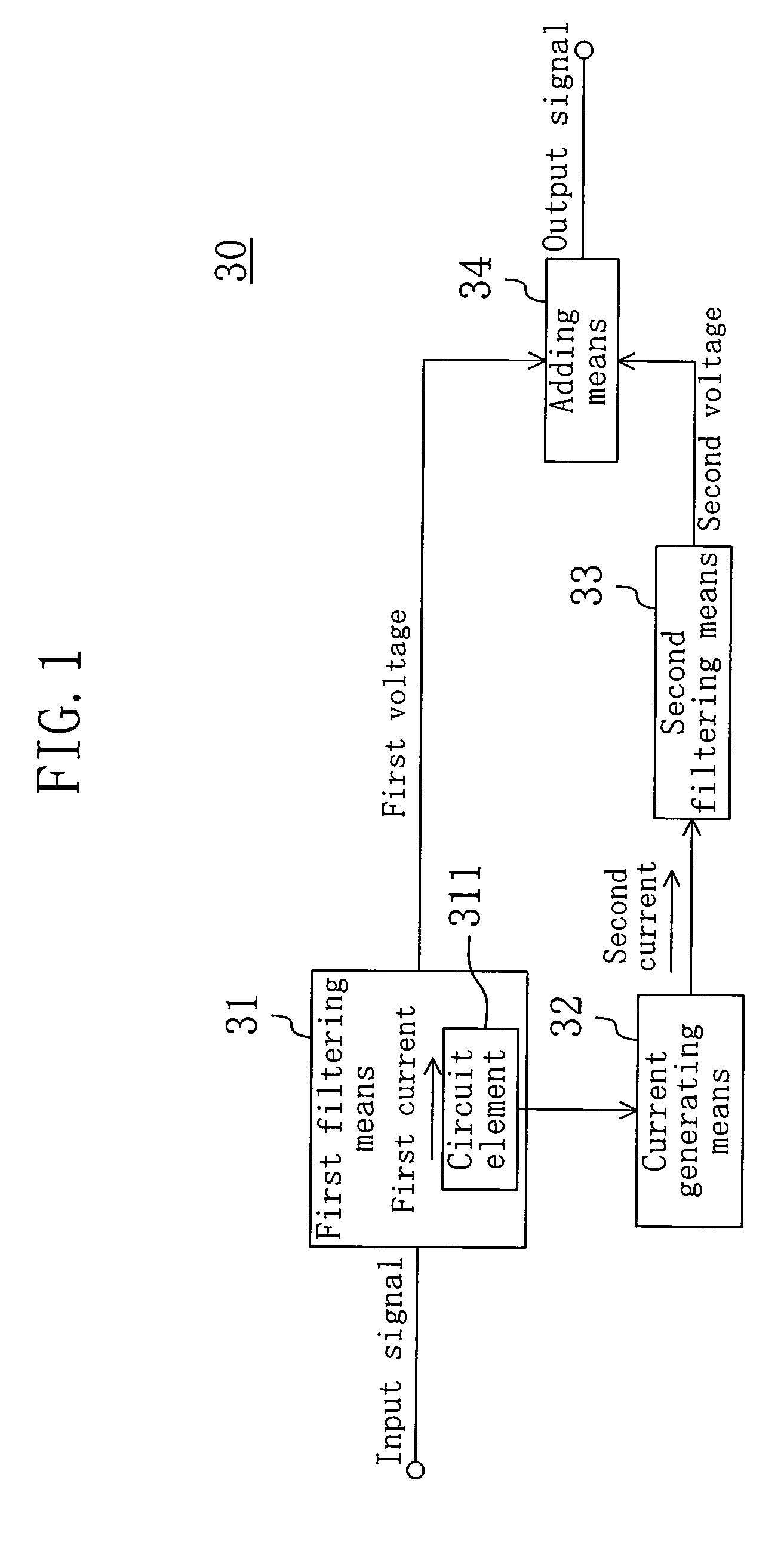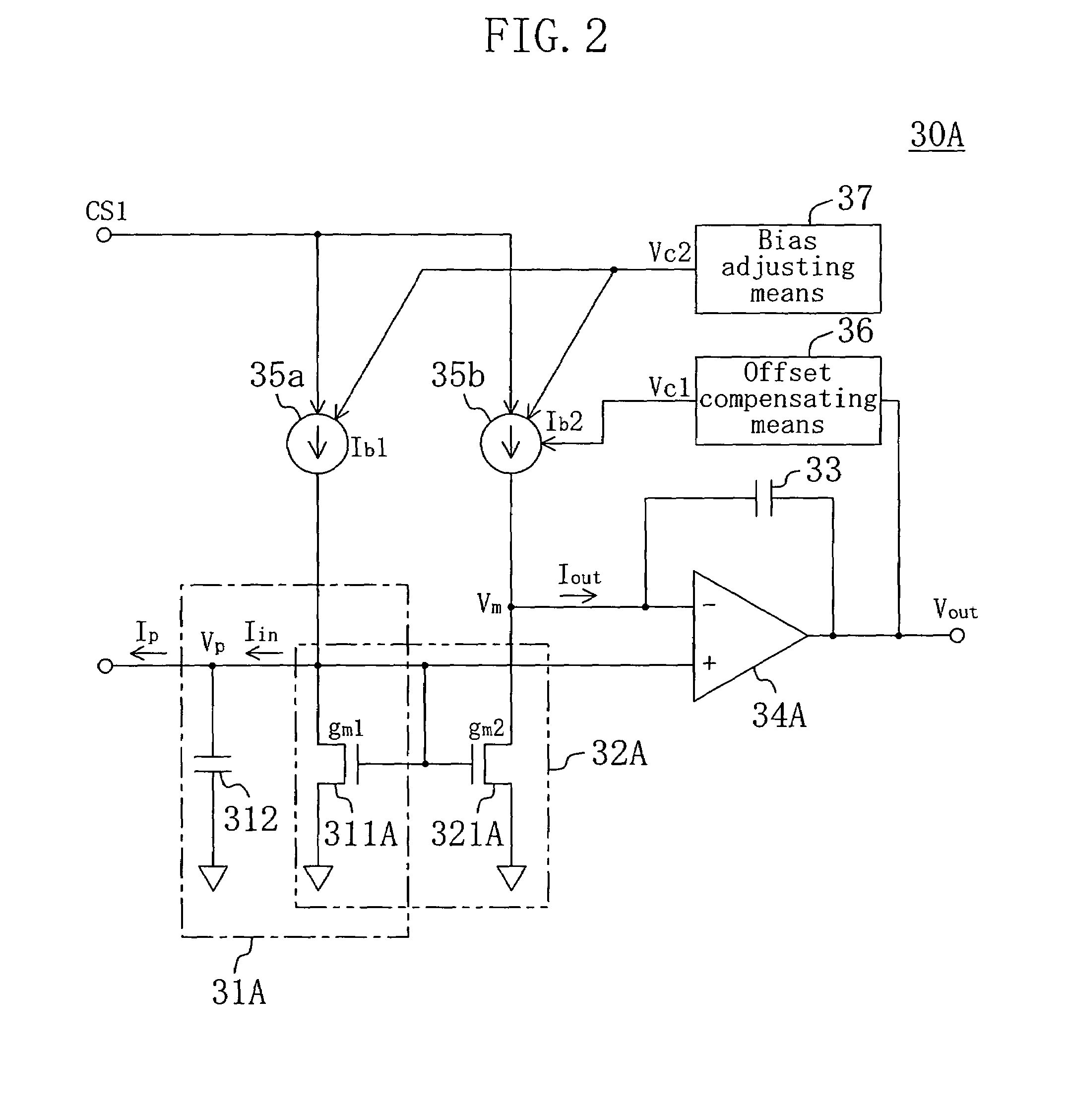Low-pass filter for a PLL, phase-locked loop and semiconductor integrated circuit
a semiconductor integrated circuit and low-pass filter technology, applied in the field of low-pass filter, can solve the problems of substantially impossible externally providing a large capacitive element on an ic card, reduce the circuit area of the pll, and change the characteristic of the filter, so as to achieve the effect of keeping the dumping factor constan
- Summary
- Abstract
- Description
- Claims
- Application Information
AI Technical Summary
Benefits of technology
Problems solved by technology
Method used
Image
Examples
embodiment 1
(Embodiment 1)
[0070]FIG. 2 shows a low-pass filter according to Embodiment 1 of the invention. The low-pass filter 30A of this embodiment is a second-order active filter including a capacitive element 312, a current mirror circuit 32A, a capacitive element 33, an operational amplifier 34A, current sources 35a and 35b, offset compensating means 36 and bias adjusting means 37. The low-pass filter 30A can be constructed as a semiconductor integrated circuit.
[0071]The low-pass filter 30A is applicable to, for example, the PLL shown in FIG. 32. In this application, the low-pass filter 30A accepts, as an input, a charge current Ip (whereas in a reverse direction to that shown in FIG. 32) from the charge pump circuit 20 and outputs a control voltage Vout, so as to control the voltage controlled oscillator 40.
[0072]The current mirror circuit 32A corresponds to the current generating means of this invention. The current mirror circuit 32A has, on its input side, a field effect transistor 311...
embodiment 2
(Embodiment 2)
[0113]FIG. 11 shows a low-pass filter according to Embodiment 2 of the invention. The low-pass filter 30B of this embodiment is obtained by modifying the adding means of the low-pass filter 30A of Embodiment 1. Herein, a difference from Embodiment 1 alone will be described. The description of elements similar to those of Embodiment 1 is omitted by referring to them with like reference numerals used in FIG. 2.
[0114]In the low-pass filter 30B, an operational amplifier 331 has the capacitive element 33 in its negative feedback portion, and accepts, as an input, a reference voltage at its non-inverting input terminal and outputs a second voltage V2. In other words, the capacitive element 33 and the operational amplifier 331 together correspond to the second filtering means in this embodiment.
[0115]An adder 34B corresponds to the adding means in this embodiment. The adder 34B accepts the first voltage Vp and the second voltage V2 as inputs, and adds these voltages to output...
embodiment 3
(Embodiment 3)
[0117]FIG. 12 shows a low-pass filter according to Embodiment 3 of the invention. The low-pass filter 30C of this embodiment is obtained by modifying the adding means of the low-pass filter 30A of Embodiment 1. Herein, a difference from Embodiment 1 alone will be described. The description of elements similar to those of Embodiment 1 is omitted by referring to them with like reference numerals used in FIG. 2.
[0118]In the low-pass filter 30C, one end of the capacitive element 33 is set to a reference voltage. Thus, the capacitive element 33 accepts the second current Iout as an input and outputs a second voltage V2 with the inverted polarity.
[0119]The adding means of this embodiment is an operational transconductance amplifier (OTA) 34C. The OTA 34C accepts, as inputs, the first voltage Vp at its non-inverting input terminal and the second voltage V2 with the inverted polarity at its inverting input terminal, and outputs a third current Iout2 as the output signal of the...
PUM
 Login to View More
Login to View More Abstract
Description
Claims
Application Information
 Login to View More
Login to View More - R&D
- Intellectual Property
- Life Sciences
- Materials
- Tech Scout
- Unparalleled Data Quality
- Higher Quality Content
- 60% Fewer Hallucinations
Browse by: Latest US Patents, China's latest patents, Technical Efficacy Thesaurus, Application Domain, Technology Topic, Popular Technical Reports.
© 2025 PatSnap. All rights reserved.Legal|Privacy policy|Modern Slavery Act Transparency Statement|Sitemap|About US| Contact US: help@patsnap.com



